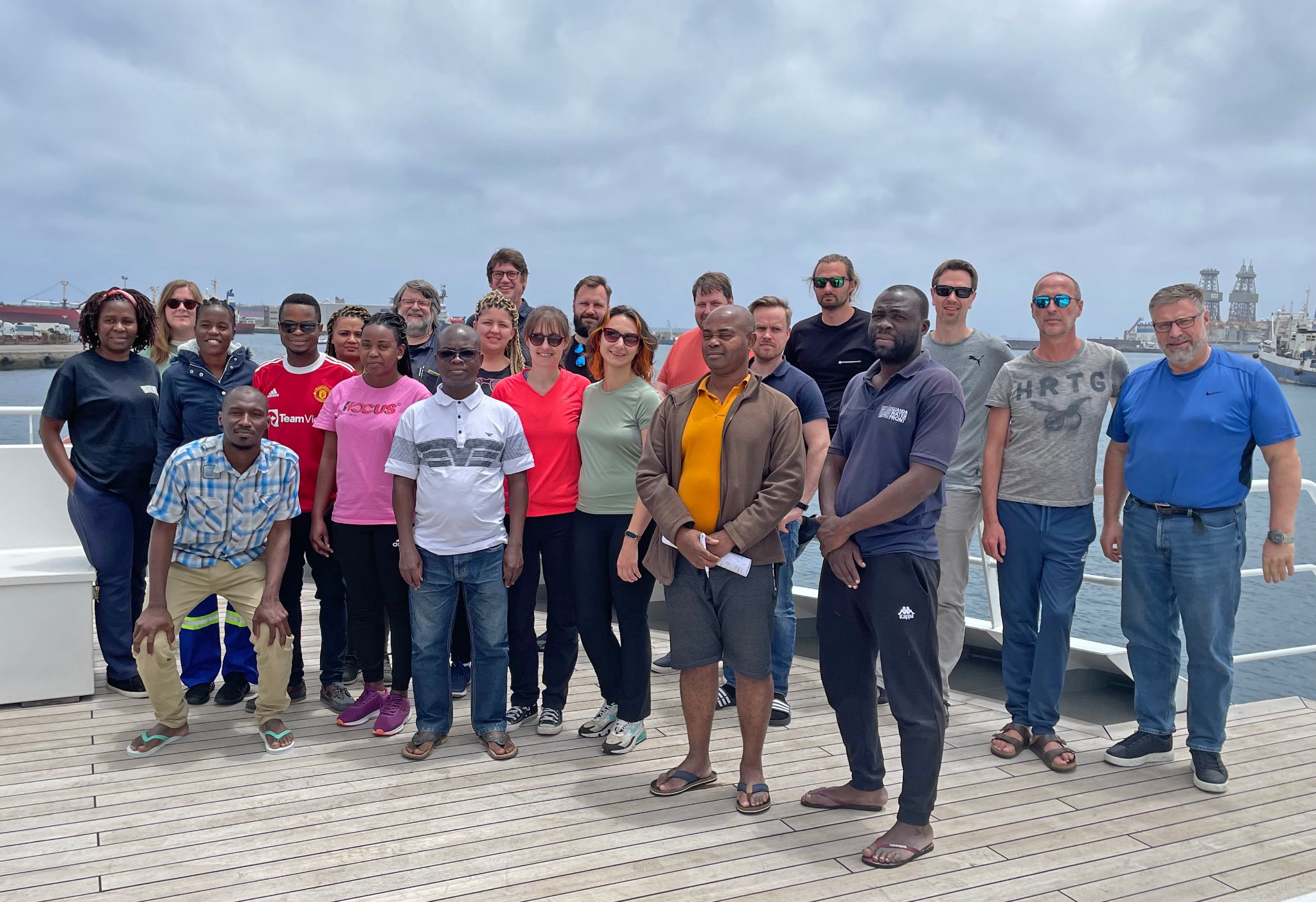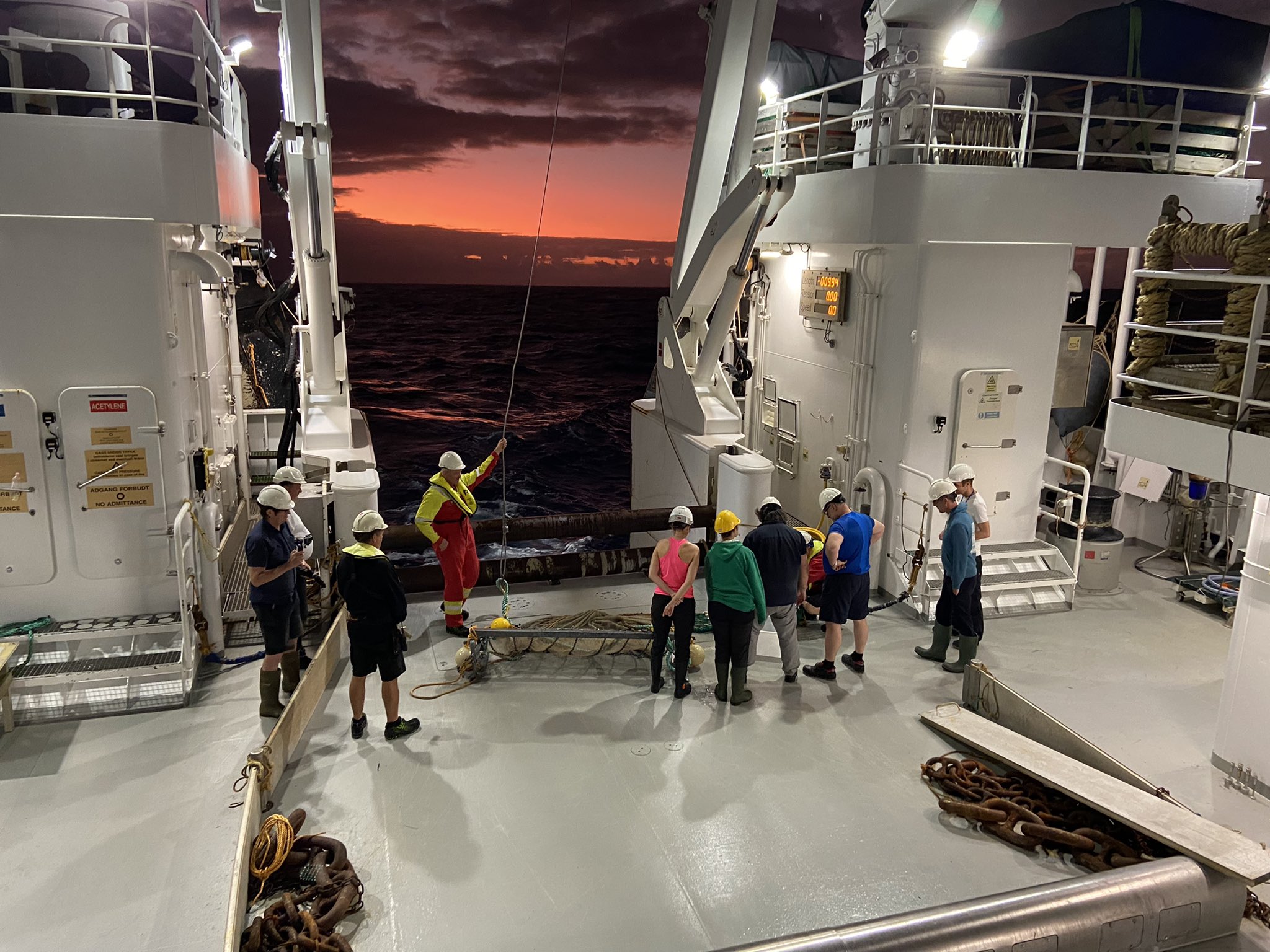Research vessel Dr Fridtjof Nansen sails beyond national borders to study corals and sponges in the depths of the southeast Atlantic Ocean
Back in 2015 and 2019, the EAF-Nansen Programme set out with the research vessel Dr Fridtjof Nansen to study seamounts in the southeast Atlantic Ocean. The research findings helped the Southeast Atlantic Fisheries Organization (SEAFO) understand what is needed to safeguard vulnerable marine ecosystems (VMEs) from significant adverse impacts from fisheries activities. The cruises also resulted in a valuable collection of specimens that were deposited at the Iziko Museum in South Africa, and that have been used for further studies to enhance knowledge on deep-sea species in the region. With much left to explore in terms of ecosystems and rich biodiversity, the EAF-Nansen Programme made it a priority to return to the SEAFO area to study additional seamounts.
 |
| Survey participants. © University of Plymouth/Dr Amelia Bridges |
In May 2022, the Dr Fridtjof Nansen was back in the southeast Atlantic Ocean to start a new survey with the aim to analyse deep-sea fish and other organisms, including indicators of VMEs, and collect samples from target species to obtain more biological information and further expand existing databases and collections to benefit regional science efforts. As for the previous expeditions, the selected study locations were situated outside national borders, in the areas beyond national jurisdiction (ABNJ) – commonly referred to as the high seas. The seamounts visited were located in existing fishing areas as well as areas closed to fishing by SEAFO.
“It was important to come back and continue the documentation of vulnerable marine ecosystems in this area,”said Dr Pål Buhl-Mortensen from the Norwegian Institute of Marine Research (IMR) and the cruise-leader of the expedition. “The findings will benefit regional scientific efforts and enhance the understanding of marine ecosystems of the Southeast Atlantic Ocean,” Dr Buhl-Mortensen continued.
During the 31 day-long expedition, 20 scientists and technicians from 8 countries (Angola, Côte d’Ivoire, Mauritania, Namibia, Norway, Spain and the United Kingdom of Great Britain and Northern Ireland), supported by researchers from the Institute of Marine Research, Norway (IMR), explored 33 locations across four seamounts that are part of the Guinea Seamount Chain located 1 700 kilometres west of Angola. The seamounts, with summits reaching between 400 and 800 meters in depth, revealed many interesting findings.
Images from the seabed, provided by advanced technology like a Video Assisted Multi Sampler (VAMS) and a Remotely Operated Vehicle (ROV), documented a variety of species that are regarded as VME indicators in the area. “A VME indicator is a species that may form habitats or aggregations that are long-lived, fragile, but also important to other species or the ecosystem. Most VME indicator species are either corals or sponges,” Dr Buhl-Mortensen explained.
Among other things, the scientists found various types of coral gardens on all seamounts, but no live coral reefs. However, an extensive collection of coral skeletons suggests that there has been living coral reefs on the seamounts in the past. Why there are so many dead and seemingly old coral skeletons along the slopes of the seamounts remains a mystery to the bottom habitat team of the survey, but by dating the collected fragments, the team believe it may be possible to figure out how and when they died. They did not see any clear signs of impact from fishing activities, such as marks on the seafloor, lost gear, or recently broken skeletons.
Ester Shoopala, a fisheries researcher from Namibia was pleased with her experiences on board the vessel. “This has been an eye-opener for the great biodiversity in the deep-sea that we otherwise don’t get to see,” Shoopala said.
 |
| Imagery from the ROV on the Guinea Seamount chain provides a close-up of some gorgonian polyps and an Iridogorgia sp. © University of Plymouth/Dr Amelia Bridges |
The detailed mapping of the bathymetry (the depths) revealed the topography of the seamounts, with their volcanic appearance and dramatic landscape. Some of the seamounts do not have names and are barely visible on the existing maps of the area. When returning to land, cruise leader Dr Buhl-Mortensen said he will explore whether it is possible to name one of them after the research vessel Dr Fridtjof Nansen – the Nansen Seamount.
Regional fisheries management organizations like SEAFO are crucial to ensure the long-term conservation and sustainable use of marine resources in the ABNJ – where no specific country has the sole responsibility for their management. In 2015, the SEAFO Commission adopted a conservation measure to protect VMEs from harmful impacts caused by fishing, using data from the EAF-Nansen Programme’s (back then called the Nansen Project) collaborative research surveys, hence demonstrating how these can serve as a scientific basis for decision-making.
“The joint efforts between Southeast Atlantic Fisheries Organization (SEAFO) and the EAF-Nansen Programme are evidently key for sustainable use of marine resources and the long-term protection of the rich marine biodiversity in the southeast Atlantic Ocean”, said Merete Tandstad - the coordinator of the EAF-Nansen Programme. She further explained that the data from the past and current surveys will continue to support SEAFO in their efforts to sustainably manage fisheries in the southeast Atlantic.
More on the topic:

